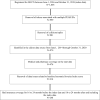Real-World Evaluation of Clinical Response and Long-Term Healthcare Resource Utilization Patterns Following Treatment with a Digital Therapeutic for Chronic Insomnia
- PMID: 35983014
- PMCID: PMC9379126
- DOI: 10.2147/CEOR.S368780
Real-World Evaluation of Clinical Response and Long-Term Healthcare Resource Utilization Patterns Following Treatment with a Digital Therapeutic for Chronic Insomnia
Abstract
Background and objectives: This analysis evaluated insomnia severity and long-term impact on healthcare resource utilization (HCRU) and costs after treatment with Somryst® (previously called SHUTi), a digital therapeutic delivering cognitive behavioral therapy for insomnia (CBT-I).
Methods: Change from baseline in insomnia severity index (ISI) score was assessed using last observed ISI score. A pre/post analysis of claims data was conducted, comparing HCRU in patients with self-identified sleep problems who successfully initiated the therapeutic (index date) between June 1, 2016 and December 31, 2018.
Results: A total of 248 patients were analyzed (median age 56.5 years, 57.3% female, mean ISI score 19.13, 52.4% treated with sleep aid medications pre-index). After 9 weeks, mean ISI score declined by 37.2% from baseline (19.1 vs 12.0), 58.8% of patients achieved ISI responder status (ISI score improved by =>7; NNT: 1.7), and 26.6% of patients achieved insomnia remission (ISI score <8; NNT for remission: 3.8). After two-year follow-up, post-index events were reduced (compared to 2 years pre-index) for emergency department visits (-53%; IRR: 0.47; 95% CI 0.27, 0.82; P=0.008), hospiatizations (-21%; IRR: 0.79; 95% CI 0.46, 1.35; P=0.389) and hospital outpatient visits (-13%; IRR: 0.87; 95% CI 0.66, 1.14; P=0.315). Slightly increased rates were observed for ambulatory surgical center visits (2%; IRR: 1.02; 95% CI 0.73, 1.44; P=0.903) and office visits (2%; IRR: 1.02; 95% CI 0.92, 1.14; P=0.672). The number of patients treated with sleep aid medications dropped 18.5% (52.4% pre-index vs 42.7% post-index). Average number of prescriptions decreased from 3.98 pre-index to 3.73 post-index (P= 0.552). Total two-year cost reduction post-index vs pre-index was $510,678, or -$2059 per patient.
Conclusion: In a real-world cohort of patients with chronic insomnia, treatment with a digital therapeutic delivering CBT-I was associated with reductions in insomnia severity, emergency department visits, and net costs.
Keywords: CBT-I; SHUTi; Somryst; chronic insomnia; cognitive behavioral therapy for insomnia; prescription digital therapeutic.
© 2022 Forma et al.
Conflict of interest statement
FF, FPT, XX, FFV, and YAM are employees of Pear Therapeutics (US), Inc. FPT also reports equity and employment from BeHealth Solutions, during the conduct of the study; and was a previous faculty member at institution (University of Virginia) that developed precursor (SHUTi) to this work. TGK and RB are employees of Market Access Consulting, Labcorp Drug Development, which participated in this study under contract with Pear Therapeutics (US), Inc. DCM is a consultant of Strategic Therapeutics, LLC, which participated in this study under contract with Pear Therapeutics (US), Inc. The authors report no other conflicts of interest in this work.
Similar articles
-
Real-world evidence from users of a behavioral digital therapeutic for chronic insomnia.Behav Res Ther. 2022 Jun;153:104084. doi: 10.1016/j.brat.2022.104084. Epub 2022 Apr 1. Behav Res Ther. 2022. PMID: 35405424
-
Real-World Reductions in Healthcare Resource Utilization over 6 Months in Patients with Substance Use Disorders Treated with a Prescription Digital Therapeutic.Adv Ther. 2022 Sep;39(9):4146-4156. doi: 10.1007/s12325-022-02215-0. Epub 2022 Jul 12. Adv Ther. 2022. PMID: 35819569 Free PMC article.
-
Protocol for Digital Real-world Evidence trial for Adults with insomnia treated via Mobile (DREAM): an open-label trial of a prescription digital therapeutic for treating patients with chronic insomnia.J Comp Eff Res. 2021 May;10(7):569-581. doi: 10.2217/cer-2021-0004. Epub 2021 Mar 8. J Comp Eff Res. 2021. PMID: 33682430 Clinical Trial.
-
Profile of Somryst Prescription Digital Therapeutic for Chronic Insomnia: Overview of Safety and Efficacy.Expert Rev Med Devices. 2020 Dec;17(12):1239-1248. doi: 10.1080/17434440.2020.1852929. Epub 2020 Dec 2. Expert Rev Med Devices. 2020. PMID: 33226269 Review.
-
Psychological treatment for insomnia in the regulation of long-term hypnotic drug use.Health Technol Assess. 2004 Feb;8(8):iii-iv, 1-68. doi: 10.3310/hta8080. Health Technol Assess. 2004. PMID: 14960254 Review.
Cited by
-
Digital cognitive-behavioural therapy application compared with zolpidem for the treatment of insomnia: protocol for an exploratory randomised controlled trial.BMJ Open. 2024 Jun 25;14(6):e081205. doi: 10.1136/bmjopen-2023-081205. BMJ Open. 2024. PMID: 38925698 Free PMC article.
-
Economic Evaluation Associated With Clinical-Grade Mobile App-Based Digital Therapeutic Interventions: Systematic Review.J Med Internet Res. 2023 Aug 1;25:e47094. doi: 10.2196/47094. J Med Internet Res. 2023. PMID: 37526973 Free PMC article.
-
The clinical effects of digital cognitive behavioral therapy for insomnia in a heterogenous study sample: results from a randomized controlled trial.Sleep. 2023 Nov 8;46(11):zsad184. doi: 10.1093/sleep/zsad184. Sleep. 2023. PMID: 37428712 Free PMC article. Clinical Trial.
-
Therapeutic Evaluation and Utilization Analysis of Mental Health Prescription Digital Therapeutics Within the Current Regulatory Landscape.Pharmacy (Basel). 2025 Feb 5;13(1):19. doi: 10.3390/pharmacy13010019. Pharmacy (Basel). 2025. PMID: 39998017 Free PMC article. Review.
References
LinkOut - more resources
Full Text Sources


